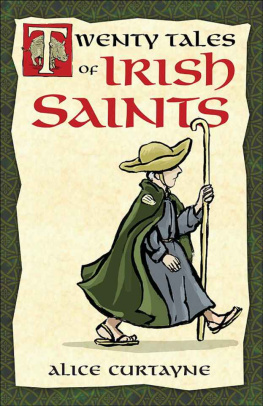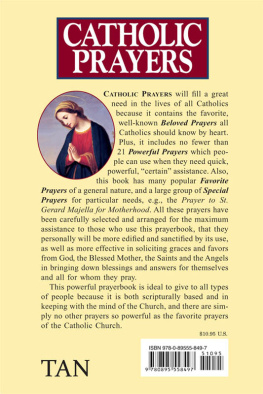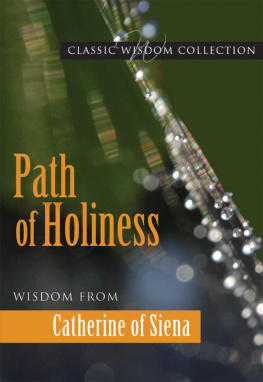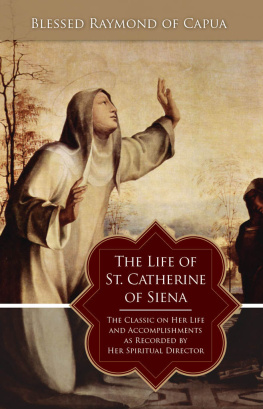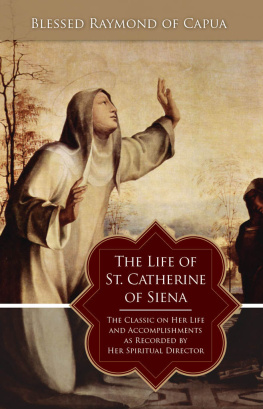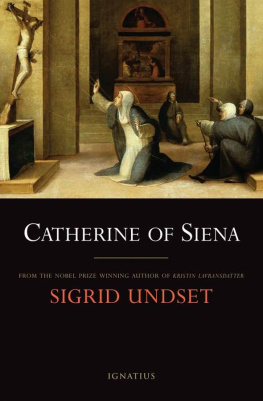Alice Curtayne - Saint Catherine of Siena
Here you can read online Alice Curtayne - Saint Catherine of Siena full text of the book (entire story) in english for free. Download pdf and epub, get meaning, cover and reviews about this ebook. year: 2016, publisher: TAN Books, genre: Non-fiction. Description of the work, (preface) as well as reviews are available. Best literature library LitArk.com created for fans of good reading and offers a wide selection of genres:
Romance novel
Science fiction
Adventure
Detective
Science
History
Home and family
Prose
Art
Politics
Computer
Non-fiction
Religion
Business
Children
Humor
Choose a favorite category and find really read worthwhile books. Enjoy immersion in the world of imagination, feel the emotions of the characters or learn something new for yourself, make an fascinating discovery.

- Book:Saint Catherine of Siena
- Author:
- Publisher:TAN Books
- Genre:
- Year:2016
- Rating:4 / 5
- Favourites:Add to favourites
- Your mark:
- 80
- 1
- 2
- 3
- 4
- 5
Saint Catherine of Siena: summary, description and annotation
We offer to read an annotation, description, summary or preface (depends on what the author of the book "Saint Catherine of Siena" wrote himself). If you haven't found the necessary information about the book — write in the comments, we will try to find it.
Saint Catherine of Siena — read online for free the complete book (whole text) full work
Below is the text of the book, divided by pages. System saving the place of the last page read, allows you to conveniently read the book "Saint Catherine of Siena" online for free, without having to search again every time where you left off. Put a bookmark, and you can go to the page where you finished reading at any time.
Font size:
Interval:
Bookmark:
Saint Catherine of Siena
Alice Curtayne
Nhl Obstat
THOMAS MCLAUGHLIN, S.T.D.
CENSOR DEPUTATUS
Imprmatur
EDM: CAN: SURMONT
VIC. GEN.
WESTMONASTERII,
12 Martii 1929
Copyright 1980 by Alice Curtayne.
Originally published in 1929 by Sheed and Ward, Ltd., London. The TAN Edition has been re-typeset and revised to include corrections of typographical errors and updated style, vocabulary, punctuation, and spelling. Typography in this edition is the property of TAN Books and may not be reproduced, in whole or in part, without written permission of the publisher.
All rights reserved. No part of this book may be reproduced or transmitted in any form or by any means, electronic or mechanical, including photocopying, recording, or by any information storage or retrieval system, without permission in writing from the publisher.
Library of Congress Catalog Card Number: 80-53745
ISBN: 978-0-89555-162-7
EPUB ISBN: 978-1-50510-342-7
MOBI ISBN: 978-1-50510-147-8
TAN Books
Charlotte, North Carolina
www.TANBooks.com
2016
CONTENTS
HISTORICAL INTRODUCTION
CATHERINE BENINCASA'S lifetime (1347 to 1380) covers that interval of change, during which the true and splendid Middle Ages merged into the definite period of their decline and decay.
Before she was a year old, a cataclysm swept over Europe in the form of a monstrous epidemic. Under the high, dappled sky of January 1348, three trading vessels from Caffa, on the Crimea, sailed into Genoa. They had fled before the plague, but brought it with them: something more sinister on board than a dead albatross. When it was discovered, they were chased out of port again, but not before they had thoroughly infected the city. Six-sevenths of the population were swept away, almost wiping out that great maritime republic. The stricken ships sailed out of the Gulf and at least one of them put in later at Marseilles, thus providing Europe with another source of death. Venice, too, harboured suspect ships about the same time. All Italy was ravaged by the disease. Then the malignant tongue of infection forked, darting across the Adriatic, to Hungary, Austria, Germany, Poland, and striking north into Switzerland. By the Spring, Spain too was full of the poison. Sicily, Sardinia, Corsica and the Balearic Islands were devastated. From Marseilles, the pestilence raced up the Rhone valley, through the Languedoc, to Flanders and Holland. It was in England by July, devouring London, almost depopulating Oxford and Cambridge. When the Scots heard of it, they thought it a convenient judgment of God on their enemies and invented a new oath: "Be the foul deth of Engelond." But it swept over the Border too, bringing ruin to Scotland, Denmark, Norway and Sweden.
The effects of this catastrophe came slowly of course. The immediate survivors did not perceive any great change in the world about them. It was at least a quarter of a century before the results began to tell. They were, therefore, becoming obvious when Catherine Benincasa was grown up. Change was then apparent everywhere. After the Black Death, the feudal system was no more; the vernacular languages sprang up (England emerged from it, speaking English). Dante and Boccaccio illustrate the transition: on one side of the bridge of death, Dante almost apologizes for using the vernacular; he has to defend the novelty. But in Catherine's day, Boccaccio takes such use for granted. The Renaissance began to stir, making tense this epoch of transition. Doubt disturbed the serene faith of the true Middle Ages and spoke through every medium of expression: the more realistic painting, the complex and ornate architecture, the thousand foppish fashions.
The effect on the Church concerns us most. The Black Death shook it at a moment when it was ill-prepared. The Papacy had already lost prestige. The dissolvent of plague completed the evil begun by Philip IV of France. This monarch, whose cold, empty stare used to unnerve his courtiers, had been absorbed all through his reign in his quarrel with Pope Boniface VIII. Without entering into the details of this historical struggle, it is certain that the closing scene of it had a profoundly depressing effect on the Christian world. Emissaries of Philip (this queer grandson of St. Louis), one William de Nogaret and Sciarra Colonna, with a mob of hired soldiers, invaded the Papal palace of Anagni where the Pope was residing. The somewhat intransigent Boniface bore himself with great dignity. A Florentine chronicler tells us that he waited impassively for the intruders, wearing all the Pontifical insignia and seated on his throne. Colonna burst in first and is said to have struck the Pope with his mailed hand. Dismayed despite himself by the tiara, keys and cross, De Nogaret restrained his companion. Boniface was kept a close prisoner for three days. He was then permitted to return to Rome, where he died a month later of high fever brought on by the outrage. Philip may be said to have won. Boniface's successor, Benedict XI, died within a year and then the French king succeeded in having elected a friend of his own, Bertrand de Got, who was crowned at Lyons in 1305 and took up his residence at Avignon under the name of Clement V. The Papacy then became and remained for seventy years more or less an instrument in French hands, a fact which continued to exasperate the rest of Christendom. This Philip the Fair was extraordinarily tenacious in his hates. It is remarkable how he pursued the dead Pope beyond the grave. He pestered Clement for six years to have Boniface condemned as a heretic and an immoral priest, and to have his body exhumed and burned. Clement, so compliant in all else, resisted this stubbornly enough. But Philip did not cease until angry mutters began to rise against him throughout Europe and three Catalonian knights made a general challenge that they would defend the name of Boniface with their swords.
When the residence of the Popes in Avignon had become an established fact, the Black Death further injured the Church, by making impossible the continuance of its best traditions. In order to exist, monasteries and religious communities everywhere had to make up their numbers hastily by curtailing their usual careful training and selection of religious. The evil effects of this were lasting. Most of these groups never again recovered their former numbers and a great part of the new members, hurriedly gathered in, proved unsuitable and thus sapped discipline and impaired the perfection of community life. The same happened in the ranks of the secular clergy. In order that public worship might continue, very young and often uneducated clerics had to be ordained. At the same time, the old Church revenues were kept in force and this brought about a great growth in the already existing abuse of pluralities. Priestly prestige was lowered through this forced abandonment of the traditional standards and through irritation over the question of revenues.
The weakening of the Holy See's independence and the harm wrought in the Church by the Black Death, explainsufficiently for our purposethe state of ecclesiastical affairs which provoked the action of this story.
Catherine Benincasa, when hardly more than a girl, set out on the amazing venture of trying to restore to the Church some part of what it had lost. Before she died, she had become one of the most-discussed women of her day. All the crowned heads of Europe knew her. It was debated whether she was a fanatic, a witch, an impostor, or a saint. She contrasted sharply with all the women of her epoch who had provoked anything like the same general discussion. Therefore, to seize the rare novelty of her position, one must visualize these contemporary women who had won fame or notoriety, and see them grouped on the stage of history behind her.
Next pageFont size:
Interval:
Bookmark:
Similar books «Saint Catherine of Siena»
Look at similar books to Saint Catherine of Siena. We have selected literature similar in name and meaning in the hope of providing readers with more options to find new, interesting, not yet read works.
Discussion, reviews of the book Saint Catherine of Siena and just readers' own opinions. Leave your comments, write what you think about the work, its meaning or the main characters. Specify what exactly you liked and what you didn't like, and why you think so.

